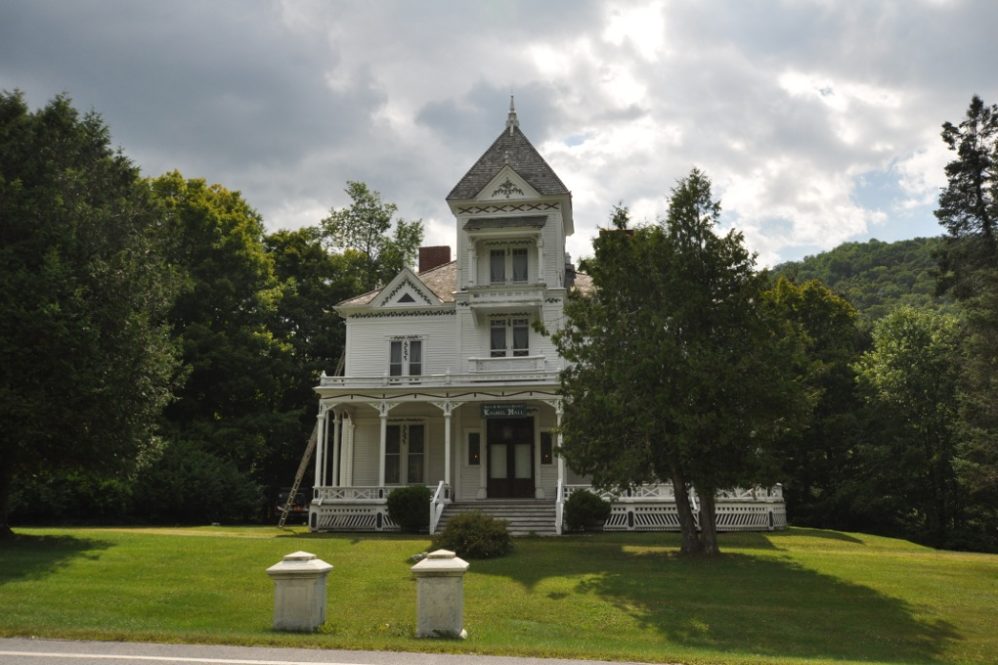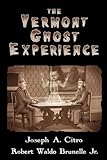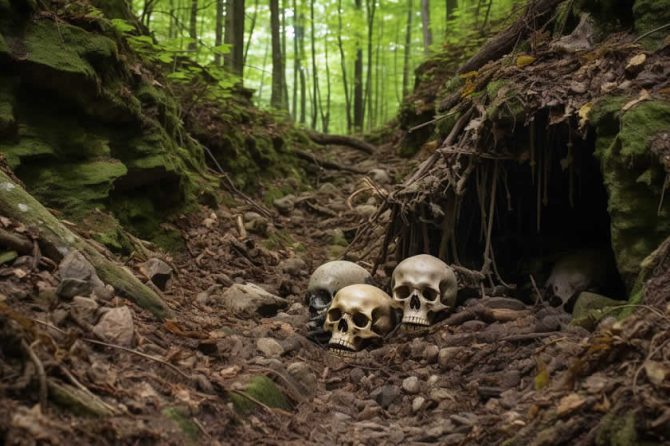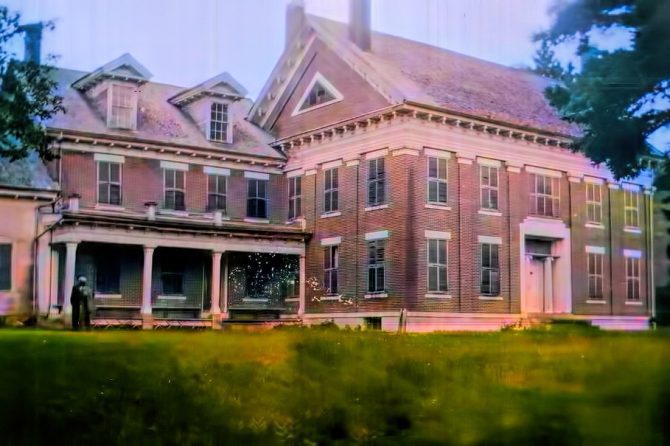Some say that the Bowman family home and tomb in Vermont are truly haunted!
If you’re driving along Route 103 in Cuttingsville, Vermont, you might very well be momentarily startled. The eerie site of a ghostly white figure standing outside the door of the Bowman Mausoleum with a wreath and key in one hand, and a top hat in the other, is unusual to say the least.
It’s hard to miss, as it is located at the front of the Laurel Glen Cemetery. However, it is merely a statue of John P. Bowman, who along with his family, is interred within the walls of the huge stone vault.
The extraordinary Vermont estate blends history, art, and a dash of the supernatural. The Bowman Mausoleum and Mansion in Laurel Glen are not just remnants of a bygone era, but a poetic tale frozen in marble and stone. Stick around, and you'll discover how John Porter Bowman turned his grief into an architectural marvel, solidifying his family's place in history.
Constructed between 1880 and 1882, the estate boasts exemplars of the Queen Anne architectural style within the primary residence and certain auxiliary structures. Notably, it encompasses a distinctive mausoleum adorned in the Egyptian Revival fashion. This impressive assemblage owes its creation to the illustrious local entrepreneur, John Porter Bowman.
Driving through the middle of Vermont and seeing a ghostly, marble figure entering a mausoleum can be a bit alarming
In 1849, Bowman married Jennie E. Gates of Warren, NY, a dignified and well-mannered woman who was a devoted wife and mother and kind neighbor. The couple moved to Stony Creek, NY to establish Bowman’s tannery business. A few years later, in 1854, a daughter was born and named Addie. Sadly, she died after just four months. A second daughter, Ella, became part of the family in 1860. She was to become a fine and respected young woman among the community.
Unfortunately, tragedy struck the family in 1879, when Ella became ill and passed away. Less than a year later, Mrs. Bowman also died, leaving her husband the lone survivor of his beloved family. In July 1880, the heartbroken John Bowman decided to construct a grand memorial for his family in his native Vermont. He found a piece of land near a burial ground in Cuttingsville, VT and hired a New York architect and designer to oversee his plans to construct a magnificent shrine to his deceased family. Over the course of a full year, more than 100 skilled sculptors, stone cutters, masons and laborers worked to build his Grecian style mausoleum. The cost at the time was $75,000 which was a fortune in those early years.
The Marble Mourner
The final touch to completing the mausoleum was to add a life size statue of John P. Bowman himself, standing outside, holding a key to the family tomb. The eternal look of grief upon his marble face along with a mourning cloak, gloves and a funeral wreath, as he walks up the steps of the tomb are both sad and haunting.
Strange and eerie occurrences have been reported around the mausoleum at night
In the year 1881, Bowman arranged to have three caskets containing the remains of his family placed within the tomb. He also arranged to have a greenhouse built upon the grounds, which would provide plants to decorate the cemetery. In fact, it was such a remarkable site that people would come to visit from miles away to picnic on the grounds. Inside the crypt is a life-size statue of his oldest daughter who passed away when she was only an infant. There are also busts of his wife and other daughter, who tragically died within just a few months of each other.
About a year later, Bowman hired a designer to construct a Victorian style mansion which he called “Laurel Hall”, to serve as a summer residence, in the grandest of style. A spectacular fountain graced the lawn and a carriage house was built nearby. For ten years, Bowman entertained family and friends at his opulent home until he passed away in 1891 at age 75. He was buried within the mausoleum across the road, finally joining his family.
Bowman believed in reincarnation and left behind an unusual request in his will
A sum of $50,000 would finance the ongoing maintenance of both the mansion and the mausoleum. It was required that the house be kept in “waiting readiness” for him and his family to return. The custodian of the property diligently carried out his instructions keeping the clocks wound, a fire in the fireplace, and lights in the windows at night, along with a hot meal at dusk. The fund was depleted in 1953, at which time much of the furniture inside the mansion was sold at auction.
The Bowman mansion seems to be the focal point for hauntings. Those who rented the mansion after 1953 claimed that it was haunted. It was left empty for a period of time, which generated rumors that the home was haunted. Tales of weird noises and strange lights have been reported to manifest themselves within the mansion. One tale told is the sounds of a phantom baby crying. The odd footnote to this is no children had ever lived inside the house, making this odd occurrence a mystery. As one might expect, strange and eerie experiences have been reported around the Bowman mausoleum at night as well.
Whether any of the above is true or not, the Bowman property, family story and especially the mausoleum are certainly unique. For a period of time, a couple ran an antiquarian “Haunted Book Shop” at the mansion but it is now closed. As of this writing in 2016, the mansion is not inhabited and maintained by the Laurel Glen Cemetery Association.
Who Was John Porter Bowman?
John Porter Bowman, born in 1816, was a man who knew how to turn a buck. Operating a successful tannery business, he made a fortune selling leather goods, primarily to the government during the Civil War. However, the Vermont native's life wasn't all sunshine and roses. The tragic loss of his wife Jennie E. and daughters Ella and Addie cast a long shadow over his achievements.
Where Is Laurel Glen Located?
Picture this: A charming Vermont landscape along Route 103 in Cuttingsville, part of the town of Shrewsbury. Laurel Glen is the dreamy setting where Bowman built his mansion and mausoleum. Just a stone's throw from Rutland, this region showcases the state of Vermont at its finest, teeming with history and nature. Laurel Hall and Laurel Glen Mausoleum form a historic estate property on Vermont Route 103 in Shrewsbury, Vermont.
What's the Story Behind the Bowman Mansion?
Laurel Hall, Bowman's mansion, isn't just some run-of-the-mill Victorian abode. Built by John and designed by New York architect George Croff in 1879, it stands as a testament to Bowman's taste and affluence. The tannery business had been kind to him, and the mansion became his summer home, a retreat for the Bowman family to enjoy life's simpler pleasures.
Why Was the Mausoleum Built?
Ah, the mausoleum—the beating heart of our tale. Built in 1880-1881, directly across the road from Laurel Hall, Bowman commissioned this sanctuary to immortalize his late wife and daughters. What makes this mausoleum stand out? Well, it took one year to complete and incorporated 50 tons of marble and tons of granite.
The Art of Mourning: The Marble Figures
Sculptor Giovanni Turini was the genius behind the mesmerizing marble figures that adorn the Bowman Mausoleum. A marble figure of Bowman himself, a wreath symbolizing eternity, and three caskets encapsulate the depths of his sorrow and his family's absence.
Is the Bowman Mausoleum Really Haunted?
Okay, who doesn't love a good ghost story? According to local legend, the estate is a hotbed for paranormal activity. The Haunted Mansion Bookshop even immortalizes these tales, setting up shop in the mansion across the road.
The Mysterious Bowman Mausoleum: Fact or Myth?
Reincarnation, you say? Yes, Bowman was a man who thought about the afterlife a bit too seriously. The Laurel Glen Cemetery Association was formed with the understanding that Bowman would be reincarnated and, therefore, would need a ‘live-in' mausoleum.
How Does Vermont Remember John Bowman?
John Porter Bowman, a man larger than life, isn't forgotten by his home state. The Vermont Historical Society and Shrewsbury Historical Society preserve his legacy, punctuated by a historical marker that tells of Bowman's contributions.
What Role Does Marble Play in the Bowman Estate?
Marble is more than just a pretty face in this narrative. It reflects Bowman's grief, carved to perfection. It's what makes the mausoleum an arresting spectacle, blending in yet standing apart from the Vermont landscape.
How Can You Visit Laurel Glen and Why Should You?
You can bask in the historical richness of the Bowman Estate by visiting along Route 103 in Cuttingsville, Vermont. Why should you? The estate offers a unique blend of history, architecture, and folklore that's second to none. Read more at the Shrewsbury Historical Society website.
FAQ's – Frequently Asked Questions
- Who Was John Porter Bowman?
- Where Is Laurel Glen Located?
- What's the Story Behind the Bowman Mansion?
- Why Was the Mausoleum Built?
- The Art of Mourning: The Marble Figures
- Is the Bowman Mausoleum Haunted?
- The Mysterious Bowman Mausoleum: Fact or Myth?
- How Does Vermont Remember John Bowman?
- What Role Does Marble Play in the Bowman Estate?
- How Can You Visit Laurel Glen and Why Should You?
Who Was John Porter Bowman?
John Porter Bowman, born in 1816, was a man who knew how to turn a buck. Operating a successful tannery business, he made a fortune selling leather goods, primarily to the government during the Civil War. However, the Vermont native's life wasn't all sunshine and roses. The tragic loss of his wife Jennie E. and daughters Ella and Addie cast a long shadow over his achievements.
Where Is Laurel Glen Located?
Picture this: A charming Vermont landscape along Route 103 in Cuttingsville, part of the town of Shrewsbury. Laurel Glen is the dreamy setting where Bowman built his mansion and mausoleum. Just a stone's throw from Rutland, this region showcases the state of Vermont at its finest, teeming with history and nature.
What's the Story Behind the Bowman Mansion?
Laurel Hall, Bowman's mansion, isn't just some run-of-the-mill Victorian abode. Built by John and designed by New York architect George Croff in 1879, it stands as a testament to Bowman's taste and affluence. The tannery business had been kind to him, and the mansion became his summer home, a retreat for the Bowman family to enjoy life's simpler pleasures.
Why Was the Mausoleum Built?
Ah, the mausoleum—the beating heart of our tale. Built in 1880-1881, directly across the road from Laurel Hall, Bowman commissioned this sanctuary to immortalize his late wife and daughters. What makes this mausoleum stand out? Well, it took one year to complete and incorporated 50 tons of marble and tons of granite.
The Art of Mourning: The Marble Figures
Sculptor Giovanni Turini was the genius behind the mesmerizing marble figures that adorn the Bowman Mausoleum. A marble figure of Bowman himself, a wreath symbolizing eternity, and three caskets encapsulate the depths of his sorrow and his family's absence.
Is the Bowman Mausoleum Haunted?
Okay, who doesn't love a good ghost story? According to local legend, the estate is a hotbed for paranormal activity. The Haunted Mansion Bookshop even immortalizes these tales, setting up shop in the mansion across the road.
The Mysterious Bowman Mausoleum: Fact or Myth?
Reincarnation, you say? Yes, Bowman was a man who thought about the afterlife a bit too seriously. The Laurel Glen Cemetery Association was formed with the understanding that Bowman would be reincarnated and, therefore, would need a ‘live-in' mausoleum.
How Does Vermont Remember John Bowman?
John Porter Bowman, a man larger than life, isn't forgotten by his home state. The Vermont Historical Society and Shrewsbury Historical Society preserve his legacy, punctuated by a historical marker that tells of Bowman's contributions.
What Role Does Marble Play in the Bowman Estate?
Marble is more than just a pretty face in this narrative. It reflects Bowman's grief, carved to perfection. It's what makes the mausoleum an arresting spectacle, blending in yet standing apart from the Vermont landscape.
How Can You Visit Laurel Glen and Why Should You?
You can bask in the historical richness of the Bowman Estate by visiting along Route 103 in Cuttingsville, Vermont. Why should you? The estate offers a unique blend of history, architecture, and folklore that's second to none.
In a Nutshell:
- John Porter Bowman's story is etched in Vermont's history, thanks to his mammoth estate at Laurel Glen.
- The Bowman Mansion, aka Laurel Hall, was a summer getaway for the Bowman clan.
- The Bowman Mausoleum is a testament to love and loss, adorned with intricate marble figures.
- Ghost stories? Yep, the estate has them too.
- Whether you're a history buff or just in it for the spook, a visit to the Bowman Mausoleum and Mansion is a must!
So there you have it, folks—a tale as old as time, written in the stones of Vermont. Grab your coats and cameras; you won't want to miss this!
Thank you for reading this post, don't forget to subscribe to our email list for the latest news!











